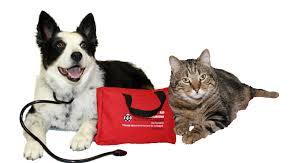April is National Pet First Aid Awareness Month. Should your pet be injured it is a good idea to see a veterinarian but in case you are in a remote area, out camping or enjoying the outdoors it is a good idea to be prepared to handle basic first aid issues for your pet and know how to best handle them without causing further injury to your pet or yourself.
Prevention is the best option regarding first aid; be as aware of the surroundings your pet has access to and insure there are no toxic materials or hazards in the vicinity. Some common concerns that may be preventable include:
- Choking – remove when pet is alone (bones, small toys, etc)
- Accidental poisoning – keep medications, toxic plants, etc out of reach
- Trauma – falls, tripping, entrapment
- Lacerations – keep sharp objects out of pet’s environment and keep furniture in good condition
Of course, not all injuries can be predicted and prevented. Having a stocked first aid kit is something that is helpful in situations where minor first aid may be needed. Some good supplies to have in your pet first aid kit include:
- Medical tape
- Gauze

- Gauze sponges/cast padding/coflex wrap
- Telfa (non stick) pads
- Triple antibiotic ointment
- Disinfectant and flush solution
- Tweezers – tick/splinter removal
- Thermometer
- Bandage scissors
- Exam gloves for you
- Syringes – for flushing wounds or administering liquids
- Anti-diarrhea medication, anti-histamine medication (be sure to know proper use and dosing)
- Leash and muzzle that fits your pet – animals may be unpredictable when injured and you do not want to lose them or get bit.
- Collapsible water/food dish
Should you need to apply a bandage to your pet be very careful to not wrap it too tight; tight bandages can cause further damage to tissues. Be sure to maintain your first aid kit; restock as needed and check expiration dates for solutions/drugs. Be familiar with what is in your kit and know how to use it. Animal body temperatures are different than people – a list of norms of vital signs is a good thing to have in your kit so you don’t have to remember (body temperature, heart and respiration rate, etc). Your veterinarian can provide you with the information that you would find helpful in your kit.
For dire emergencies that require CPR or more advanced care please take a Pet First Aid Class. Look in your area for a local class or at minimum search online. For bleeding, apply pressure and bandage if possible. Broken bones may need to be splinted or immobilized before your pet can be moved. If your pet is not breathing – check airway for blockage then start CPR if you are educated. It is key to remain calm in these situations – you pet will be scared and they will need you to be calm and confident. In these types of situations, take your pet to a local veterinary emergency clinic as quickly as possible.
Finally, be sure to call your veterinarian or schedule an appointment if you have any questions regarding injury to your pet. Small injuries can get infected and require further treatment; broken toenails are notorious for getting infected and causing pain. Eye injuries are always severe and should be evaluated by a veterinarian. Prevent injuries when you can or be prepared for them when you are out having fun. Take care of your pet and tell a friend about National Pet First Aid Awareness Month!

